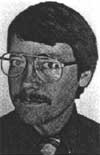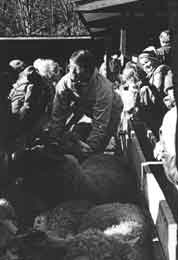Fall 1985 // Volume 23 // Number 3 // Feature Articles // 3FEA3
The Livestock Masters Program: It Works
Abstract
A proven idea in a different setting.
Note from the editor:
Recently, James Long and Michael Hackett spent an afternoon discussing one phase of Mike's county ag program-the part that deals with smaller-scale livestock farmers. We thought you'd like to listen in on part of their conversation.
 |
 |
| James Long | Michael Hackett |
Jim: What is the Livestock Masters Program?
Mike: It's a newer-perhaps, unique-Extension effort in Snohomish County in which adults who have raised livestock complete additional training and volunteer 50 hours during the year to advise other residents on small-scale animal production.
Jim: In what ways do they advise?
Mike: Livestock Masters (LM) handle many questions that come to the Extension office by phone; they make farm calls; they meet the public directly at the office, fairs, and shows. For example, last Saturday, four LM's helped staff the stations set up for 300 people who came to our annual "lambing day."
I estimate that in 1984, the LM's made 900 contacts with the public-a good investment, I believe, for a new program that takes 10% of my time as an agent.
Jim: How did the program get started?
Mike: When I came to Snohomish County in 1980,1 noticed what a mix of people Extension serves here. We have city folks and large, commercial farmers in the valley-truck crop producers and dairy producers.
Also, we've recently seen a rapid rise in the number of families who have moved to a small acreage anywhere between the Pacific Coast and the Cascade Mountains on the east.
A third of these "new settlers" wanted to supplement family income through smallscale farming; other families wanted a better quality of life. All wanted to make good use of their land and were hungry for current information. Just the sheer volume of questions about small farm planning, soils, horticulture, field crops, livestock, economics . . . overwhelmed our staff of three ag agents. We needed more technical help to serve this newer clientele, but we didn't have resources to employ assistants.
So, in 1983, building on our experience with the Master Gardener and Master Food Preserver Programs, we decided to launch another "multiplier" program that capitalized on the experience of veteran farmers who volunteered to help us in one of our highest demand areas in agriculture--small scale livestock production.
Jim: I've heard of just a few Extension volunteer programs in agriculture. It seems most Extension small farm programs hire program assistants who deal with the whole farmnot just livestock. But you chose to recruit volunteers to advise in primarily animal production.
Mike: Yes. It's quite an experiment. Our experience these first two years and a recent interim evaluation suggest that our Livestock Masters are willing and able to offer the public credible information in small-scale livestock production.
Jim: What do you believe contributes to their competence and commitment?
Mike: I believe that centers around several factors: volunteer leadership, recruitment, and training.
In 1983, two experienced farmers stepped forward to help Extension set up a new educational program. They'd raised livestock before, were livestock enthusiasts, and wanted Extension to help newcomers get off to a good start. They personally wanted to dig into the latest research themselves.
A second big factor was recruitment. We were able to recruit residents who'd raised at least two species of livestock. As a group, the 9 volunteers in 1983 and 15 volunteers in 1984 had raised all major livestock species. Another thing about recruitment-their own farms were dispersed throughout the county near most of our neighborhoods.
Training was a third contribution-the Basic Course and also a variety of continuing education experiences, as well. In both the 1983 and 1984 Basic Course, we spent 14 hours on each of 6 groups of livestock: poultry and small animals, dairy goats, sheep, beef, hogs, and horses. We emphasized production practices-feeding, housing, pest control, "what to do `til the vet comes," and production economics.
Jim: What did the LM's think of the Basic Course?

Mike: We recently asked graduates from the class of '83 and participants in the class of '84 to interview each other. We received clear, helpful signals on how to plan the 1985 course.
First, for the most part, the training built the volunteers' confidence. Some people in the poultry unit said: "The class gave me the confidence to answer poultry questions." "Information was helpful; feel I could successfully raise in the future." "Helped establish guidelines for my own poultry business."
Second, based on their experience as LM's and producers themselves, the graduates and participants also suggested that the 1985 Basic Course put less emphasis on some species and more on others-horses, honey bees, and waterfowl.
Third, they recommended some even more basic instruction "anatomy . . . so we know whereto inject," for instance.
Jim: How important has processing and marketing become?
Mike: The LM's have asked for more training on these two aspects. But, we haven't decided how to handle that yet; the Basic Course is so full now. We do notice that some families are now moving into processing and marketing-a poultry processing plant on one place, for example, that's licensed by USDA and serves the neighborhood. Seems this stimulates even more backyard production of poultry meat for home consumption.
And then there's a beef operation that now sells exclusively to a restaurant in Seattle. And while we're discussing these spin-offs, I want to mention a new farm supply store that caters to small-scale farmers . . . doesn't even try to serve the commercial vegetable and dairy producers in the valley.
Jim: What continuing education is offered to the LM's?
Mike: First is our monthly newsletter "Sundown Farmer." We feature upcoming events and technical stuff like "equine parasite control" and the New Zealand fence for small pastures.
Another is an evening meeting each month at an LM's home, filled with talk about our host's livestock enterprises, new information from WSU (Washington State University) and industry, upcoming events, and the homemade refreshments-like smoked pheasant and goat milk ice cream.
Jim: Does a "sense of experimentation" contribute to competence and commitment?
Mike: I believe it's a key. True, the LM's come to the program with a lot of livestock production experience. But they continue to broaden and deepen their skills. We found out from the recent interviews, for example, that since becoming LM's, about half have raised species that they hadn't raised before and about three-fourths have purposefully changed their production practices and explained why they made those changes.
Three of the LM's even offered to help WSU conduct field experiments! They're swine enthusiasts; one of them bought a boar from WSU last year. Another example is the LM who's breeding sheep for specific fleece qualities.
We also see this sense of experimentation in the way they offer advice. About threefourths said they'd changed the ways they help others learn about livestock: "listening better," "asking questions more carefully," and "being more familiar with resource materials and distributing them." They told us they want to learn other techniques, like how to videotape live events to use later in teaching.
Jim: What does "becoming more of a group" contribute?
Mike: It's more of the social side of the program the monthly meetings in homes and the field trip that caps off each year's Basic Course. Take that 1,000 mile trip together in a van to Pullman last summer. It made a big difference in the way the LM's felt about their work together in the county and about their work with the WSU researchers and Extension faculty. On the evaluation, one participant said: "A plus was getting to know the location and faces of those responsible for producing the information we give out." Another one concluded: "It helped bring the group together."
But there's another point here-the LM's now see opportunities to specialize a little by building a network among themselves; they're referring questions to each other more often.
A number of LM's who have already volunteered far more than their 50 hours have formed a "Foundation" to assume new teaching tasks and new leadership roles in 1985. One respondent said it was to free up my time for more teaching.
Jim: What do you see as a major value of this program?
Mike: Our recognizing the volunteers as an acknowledged link in the land-grant system that's working to discover and help others apply research-based knowledge to smallscale livestock enterprises.
Jim: How can our Journal readers learn more about LM's?
Mike: I'd be happy to send anyone our organizational policy, Basic Course outline, a copy of our "Sundown Farmer," and evaluations. Just write to me at:
- Snohomish County Extension
600 128th SE
Everett, WA 98204
